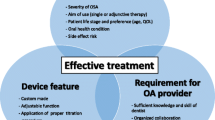Abstract
Objectives
To verify the effects of oral appliance (OA) on upper airway morphology under intraluminal pressure, identify specific sites of upper airway collapsibility that can be reversed by OAs, and determine the relationship between OA efficacy and dynamic upper airway changes using computed tomography (CT) with Muller’s maneuver.
Materials and methods
Nineteen adult Chinese patients with symptomatic mild-to-moderate sleep apnea were recruited from our sleep center. Each patient was fitted with a two-piece OA. Dynamic changes in the retropalatal and retroglossal airway were evaluated using CT at end-expiration and during Muller’s maneuver, both with and without an OA.
Results
Upper airway changes in the end-expiration phase before OA placement did not significantly differ from those after OA placement. However, under intraluminal pressure induced by Muller’s maneuver, OA effectively expanded the upper airway at multiple levels. In addition, OA counteracted negative intraluminal pressure more effectively in the retropalatal region than in the retroglossal region, with 95.65, 68.75, 72.41, and 78.38 % improvements in the collapsibility index of the anteroposterior dimension, transverse dimension, minimum cross-sectional area, and volume of the retropalatal region, respectively. Both nonresponders and responders to OA treatment were sensitive to the intraluminal pressure induced by Muller’s maneuver. However, the collapsibility of the retropalatal airway improved significantly only in the responders, not in the nonresponders.
Conclusions
OA effectively treats OSAHS by improving upper airway collapsibility.

Similar content being viewed by others
References
Malhotra A, White DP (2002) Obstructive sleep apnoea. Lancet 360(9328):237–245
Lurie A (2011) Obstructive sleep apnea in adults: epidemiology, clinical presentation, and treatment options. Adv Cardiol 46:1–42
Zhao Y, Tao L, Nie P, Lu X, Xu X, Chen J, Zhu M (2013) Association between 5-HT2A receptor polymorphisms and risk of obstructive sleep apnea and hypopnea syndrome: a systematic review and meta-analysis. Gene 530(2):287–294
Chan AS, Lee RW, Srinivasan VK, Darendeliler MA, Grunstein RR, Cistulli PA (2010) Nasopharyngoscopic evaluation of oral appliance therapy for obstructive sleep apnoea. Eur Respir J 35(4):836–842
Kushida CA, Morgenthaler TI, Littner MR, Alessi CA, Bailey D, Coleman J Jr, Friedman L, Hirshkowitz M, Kapen S, Kramer M et al (2006) Practice parameters for the treatment of snoring and Obstructive Sleep Apnea with oral appliances: an update for 2005. Sleep 29(2):240–243
Johal A, Gill G, Ferman A, McLaughlin K (2007) The effect of mandibular advancement appliances on awake upper airway and masticatory muscle activity in patients with obstructive sleep apnoea. Clin Physiol Funct Imaging 27(1):47–53
Ng AT, Gotsopoulos H, Qian J, Cistulli PA (2003) Effect of oral appliance therapy on upper airway collapsibility in obstructive sleep apnea. Am J Respir Crit Care Med 168(2):238–241
Tsuiki S, Lowe AA, Almeida FR, Kawahata N, Fleetham JA (2004) Effects of mandibular advancement on airway curvature and obstructive sleep apnoea severity. Eur Respir J 23(2):263–268
Sutherland K, Deane SA, Chan AS, Schwab RJ, Ng AT, Darendeliler MA, Cistulli PA (2011) Comparative effects of two oral appliances on upper airway structure in obstructive sleep apnea. Sleep 34(4):469–477
Sam K, Lam B, Ooi CG, Cooke M, Ip MS (2006) Effect of a non-adjustable oral appliance on upper airway morphology in obstructive sleep apnoea. Respir Med 100(5):897–902
Tsuiki S, Ryan CF, Lowe AA, Inoue Y (2007) Functional contribution of mandibular advancement to awake upper airway patency in obstructive sleep apnea. Sleep Breathing 11(4):245–251
Almeida FR, Tsuiki S, Hattori Y, Takei Y, Inoue Y, Lowe AA (2011) Dose-dependent effects of mandibular protrusion on genioglossus activity in sleep apnoea. Eur Respir J 37(1):209–212
Terris DJ, Hanasono MM, Liu YC (2000) Reliability of the Muller maneuver and its association with sleep-disordered breathing. Laryngoscope 110(11):1819–1823
Ko MT, Su CY (2008) Computer-assisted quantitative evaluation of obstructive sleep apnea using digitalized endoscopic imaging with Muller maneuver. Laryngoscope 118(5):909–914
Soares MC, Sallum AC, Goncalves MT, Haddad FL, Gregorio LC (2009) Use of Muller's maneuver in the evaluation of patients with sleep apnea–literature review. Braz J Otorhinolaryngol 75(3):463–466
Ritter CT, Trudo FJ, Goldberg AN, Welch KC, Maislin G, Schwab RJ (1999) Quantitative evaluation of the upper airway during nasopharyngoscopy with the Muller maneuver. Laryngoscope 109(6):954–963
Kyung SH, Park YC, Pae EK (2005) Obstructive sleep apnea patients with the oral appliance experience pharyngeal size and shape changes in three dimensions. Angle Orthod 75(1):15–22
Borowiecki B, Pollak CP, Weitzman ED, Rakoff S, Imperato J (1978) Fibro-optic study of pharyngeal airway during sleep in patients with hypersomnia obstructive sleep-apnea syndrome. Laryngoscope 88(8 Pt 1):1310–1313
Hsu PP, Han HN, Chan YH, Tay HN, Brett RH, Lu PK, Blair RL (2004) Quantitative computer-assisted digital-imaging upper airway analysis for obstructive sleep apnoea. Clin Otolaryngol Allied Sci 29(5):522–529
Wu MJ, Ho CY, Tsai HH, Huang HM, Lee PL, Tan CT (2011) Retropalatal Muller grade is associated with the severity of obstructive sleep apnea in non-obese Asian patients. Retropalatal Muller grade and OSA in non-obese. Sleep Breathing 15(4):799–807
Choi JK, Hur YK, Lee JM, Clark GT (2010) Effects of mandibular advancement on upper airway dimension and collapsibility in patients with obstructive sleep apnea using dynamic upper airway imaging during sleep. Oral Surg Oral Med Oral Pathol Oral Radiol Endod 109(5):712–719
Sanner BM, Heise M, Knoben B, Machnick M, Laufer U, Kikuth R, Zidek W, Hellmich B (2002) MRI of the pharynx and treatment efficacy of a mandibular advancement device in obstructive sleep apnoea syndrome. Eur Respir J 20(1):143–150
Cohen-Levy J, Petelle B, Pinguet J, Limerat E, Fleury B (2013) Forces created by mandibular advancement devices in OSAS patients : a pilot study during sleep. Sleep Breathing 17(2):781–789
Acknowledgments
This work is supported by grant from Science and Technology Committee of Shanghai Science Foundation (Grant No. 11140902001) to Prof. Min Zhu.
Conflict of interest
None declared.
Author information
Authors and Affiliations
Corresponding author
Rights and permissions
About this article
Cite this article
Zhao, Y., Shi, H., Lu, X. et al. Oral appliance effectively reverses Muller’s maneuver-induced upper airway collapsibility in obstructive sleep apnea and hypopnea syndrome. Sleep Breath 19, 213–220 (2015). https://doi.org/10.1007/s11325-014-0994-9
Received:
Revised:
Accepted:
Published:
Issue Date:
DOI: https://doi.org/10.1007/s11325-014-0994-9




